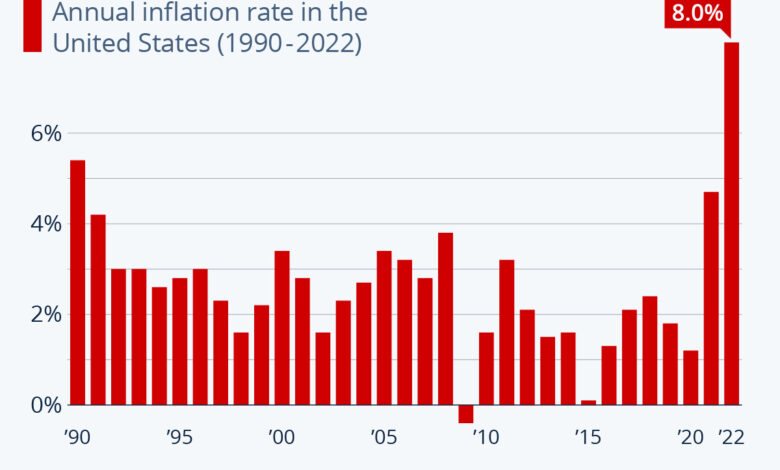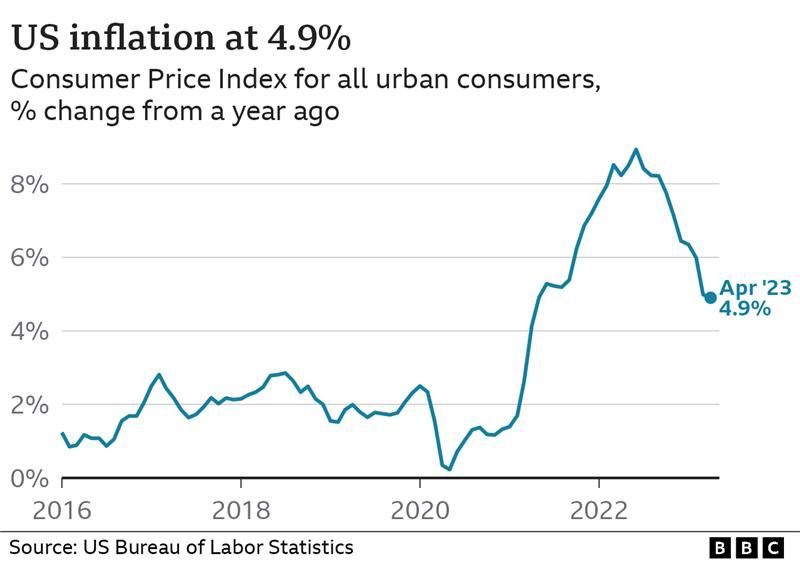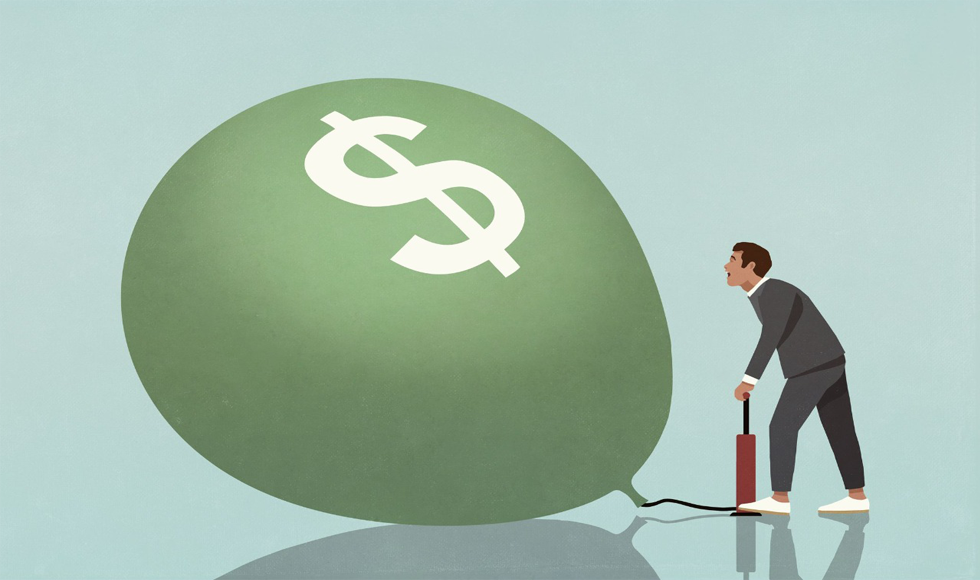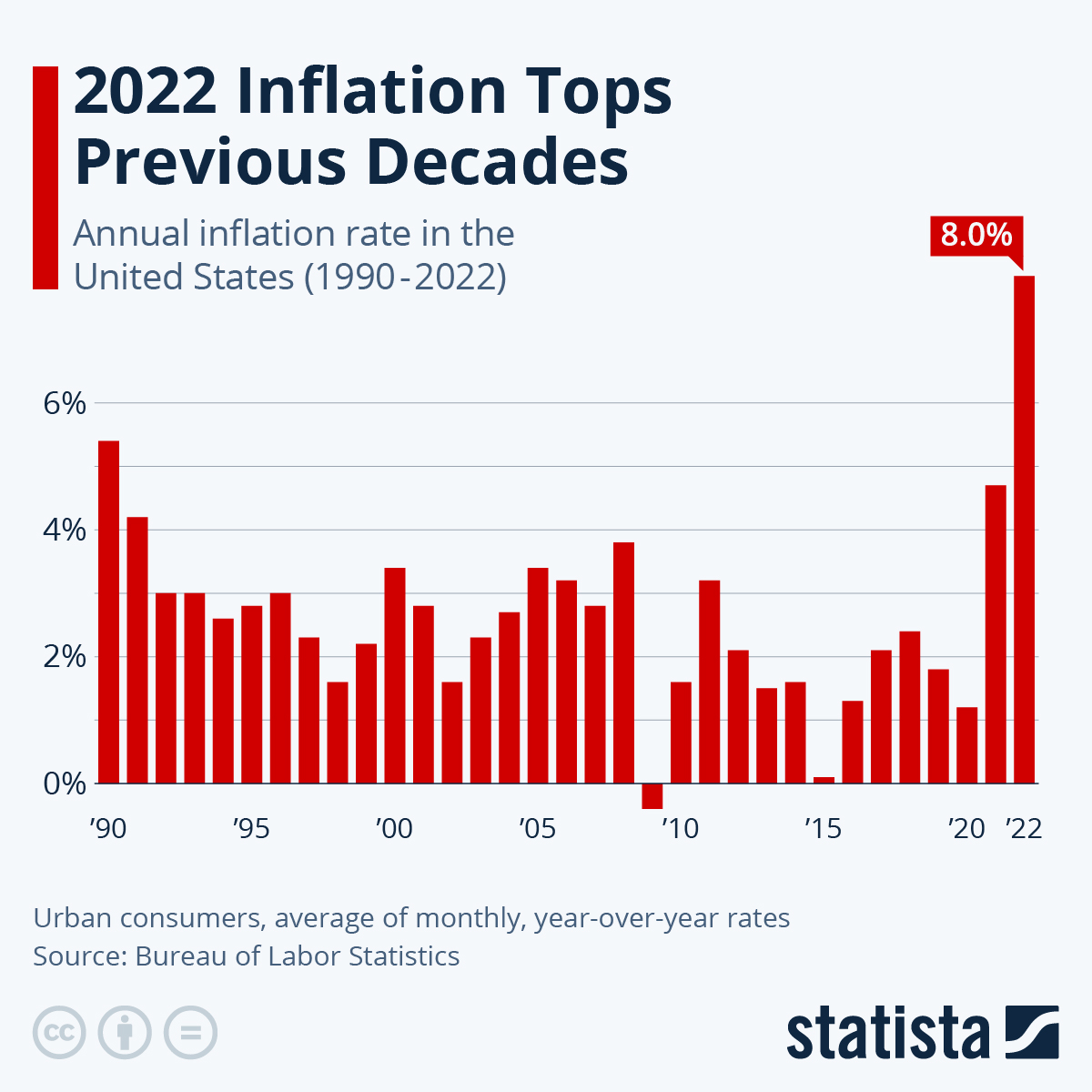
Inflation Rises for First Time This Year: What It Means for You
Inflation Rises for First Time This Year: What It Means for You. This headline might sound alarming, but it’s a reality we’re facing. After months of relatively stable prices, the cost of goods and services has started to climb again.
This shift has a ripple effect on our wallets, our economic outlook, and the decisions we make as consumers.
Understanding inflation is crucial. It’s not just about higher prices at the grocery store; it’s about the erosion of our purchasing power. As inflation rises, the value of our money decreases, meaning we can buy less with the same amount of cash.
This phenomenon can be unsettling, especially if you’re already feeling the pinch of rising costs.
Understanding Inflation

Inflation is a general increase in the prices of goods and services in an economy over a period of time. When inflation occurs, the purchasing power of money decreases, meaning that you can buy fewer goods and services with the same amount of money.
Causes of Inflation
Inflation can be caused by a variety of factors, including:
- Demand-pull inflation:Occurs when there is too much money chasing too few goods. This can happen when there is a surge in consumer spending or government spending.
- Cost-push inflation:Occurs when the cost of production increases, such as when wages rise or the price of raw materials increases.
This can lead to businesses raising prices to maintain their profit margins.
- Built-in inflation:Occurs when wages and prices rise in a self-perpetuating cycle. For example, if workers demand higher wages due to inflation, businesses may raise prices to cover the increased labor costs, leading to further inflation.
- Imported inflation:Occurs when the prices of imported goods increase, which can be caused by factors such as a weaker domestic currency or increased demand for imported goods.
Types of Inflation
There are several types of inflation, including:
- Creeping inflation:A gradual and steady increase in prices, typically less than 3% per year.
- Galloping inflation:A rapid increase in prices, typically between 10% and 100% per year.
- Hyperinflation:An extremely rapid increase in prices, typically exceeding 50% per month.
Historical Examples of Inflation
Inflation has been a recurring problem throughout history. Here are some notable examples:
- The Weimar Republic (1920s):Germany experienced hyperinflation after World War I, leading to economic collapse and social unrest. Prices rose so rapidly that people would carry wheelbarrows full of cash to buy groceries.
- The Great Inflation (1970s):The United States experienced high inflation in the 1970s, reaching a peak of over 14% in 1979.
This was partly due to the oil crisis of 1973 and the Vietnam War.
- The Venezuelan Crisis (2010s):Venezuela has experienced hyperinflation since the 2010s, with prices rising by thousands of percent per year. This has been caused by a combination of factors, including government mismanagement, falling oil prices, and economic sanctions.
Impact of Inflation
Inflation can have a significant impact on individuals, businesses, and the economy as a whole.
- Reduced purchasing power:Inflation erodes the purchasing power of money, meaning that people can buy fewer goods and services with the same amount of money.
- Increased cost of living:Inflation increases the cost of living, making it more difficult for people to afford basic necessities such as food, housing, and transportation.
The news that inflation rose for the first time this year came as a bit of a shock, especially given the economic headwinds we’ve been facing. It seems like companies are struggling to keep up, and some are even resorting to drastic measures.
Take Zovio, for example, which is exploring selling parts of its business as net losses continue. It’s a reminder that even in the face of rising inflation, companies need to adapt and find ways to stay afloat.
- Uncertainty and instability:High inflation can create uncertainty and instability in the economy, making it difficult for businesses to plan and invest.
- Erosion of savings:Inflation can erode the value of savings, as the real value of money decreases over time.
- Distorted investment decisions:Inflation can distort investment decisions, as investors may be tempted to invest in assets that are expected to appreciate in value faster than the rate of inflation.
It’s tough to see inflation rise for the first time this year, especially with all the other economic worries we’re facing. And now, on top of that, we’re hearing that under Biden’s defense budget, the US Air Force will continue to shed fighters.
It’s a double whammy – rising prices AND a weaker defense. It’s going to be interesting to see how this all plays out in the long run.
Causes of the Inflation Rise

The recent rise in inflation, after a period of relative stability, is a complex issue with multiple contributing factors. This section delves into the key drivers behind this increase, examining the role of supply chain disruptions and the impact of heightened consumer demand.
Supply Chain Disruptions
Supply chain disruptions have been a major contributor to inflation. The COVID-19 pandemic triggered widespread lockdowns and border closures, disrupting global trade flows and causing shortages of essential goods. These disruptions have led to increased transportation costs, production delays, and higher prices for manufacturers.
- Increased Shipping Costs:The pandemic led to a surge in demand for shipping containers, resulting in a shortage and significantly higher freight rates. This has increased the cost of transporting goods across the globe, contributing to higher prices for consumers.
- Production Bottlenecks:Factory closures and labor shortages caused by the pandemic have slowed down production processes. This has led to delays in delivering goods to market, creating shortages and pushing up prices.
- Raw Material Shortages:Disruptions in supply chains have also affected the availability of raw materials, leading to price increases. For example, the global semiconductor shortage has impacted the production of automobiles, electronics, and other goods.
Increased Consumer Demand, Inflation rises for first time this year
The post-pandemic economic recovery has fueled a surge in consumer demand, contributing to inflationary pressures. As economies reopened, consumers unleashed pent-up demand, leading to a surge in spending on goods and services. This increased demand has outpaced supply in many sectors, driving up prices.
It’s a strange world we live in. Inflation is on the rise for the first time this year, but the news cycle is dominated by something completely different: dozens of Planet Fitness locations receiving bomb threats over their transgender locker room policy.
It makes you wonder what’s more important to people – the cost of living or the ability to exercise in a space that feels safe and welcoming to all? Perhaps, like the economy, these are issues we’ll be wrestling with for a long time to come.
- Government Stimulus Measures:Government stimulus packages aimed at supporting economies during the pandemic have increased disposable income for many consumers. This has fueled demand for goods and services, further contributing to inflation.
- Shift in Spending Patterns:The pandemic led to a shift in consumer spending patterns, with a greater emphasis on goods than services. This shift in demand has put pressure on supply chains, leading to higher prices for goods.
- Strong Labor Market:A robust labor market with low unemployment has boosted consumer confidence and spending. This has led to increased demand for goods and services, contributing to inflation.
Economic Implications

Rising inflation has significant economic implications, affecting both businesses and consumers. It can lead to reduced purchasing power, increased business costs, and potential economic instability. Understanding these implications is crucial for navigating the economic landscape and making informed decisions.
Impact on Businesses and Consumers
Rising inflation presents challenges for businesses and consumers alike.
- Businessesface increased costs for raw materials, labor, and other inputs, leading to higher prices for their products and services. This can erode profit margins and make it difficult to compete in a market where consumers are increasingly price-sensitive.
- Consumersexperience a decline in purchasing power as their money buys less. This can force them to cut back on spending, potentially leading to a slowdown in economic activity.
Challenges to Economic Growth and Stability
Inflation can pose significant challenges to economic growth and stability.
- Reduced Investment: High inflation can discourage businesses from investing in new projects, as the future value of their returns becomes uncertain. This can lead to slower economic growth.
- Wage-Price Spiral: As prices rise, workers demand higher wages to maintain their standard of living. Businesses, in turn, raise prices to cover their increased labor costs, leading to a cycle of inflation. This can be difficult to break and can lead to economic instability.
- Uncertainty and Risk: High inflation creates uncertainty for businesses and consumers, making it difficult to plan for the future. This can lead to reduced spending and investment, further hindering economic growth.
Historical Trends and Insights
Comparing the current inflation rate to historical trends provides valuable insights.
- Inflation Rates in the United States: The United States has experienced periods of both high and low inflation throughout its history. The highest inflation rate was recorded in 1947, at 14.4%. However, inflation has been relatively low and stable in recent decades.
- Global Inflation Trends: Inflation has been rising globally in recent years, driven by factors such as supply chain disruptions, rising energy prices, and increased demand. The International Monetary Fund (IMF) estimates that global inflation will reach 8.8% in 2022, the highest level in decades.
Government Responses: Inflation Rises For First Time This Year
Governments around the world are grappling with rising inflation, a phenomenon that erodes purchasing power and can destabilize economies. To combat this, they are employing a range of measures aimed at curbing price increases and mitigating the negative impacts on households and businesses.
These measures are often tailored to specific economic conditions and can vary in their effectiveness.
Monetary Policy
Central banks play a crucial role in controlling inflation through monetary policy. The primary tool is adjusting interest rates. By raising interest rates, central banks make it more expensive for businesses and individuals to borrow money, leading to reduced spending and potentially slowing down economic activity.
This, in turn, can help to curb inflation. For example, the Federal Reserve in the United States has raised interest rates several times in recent months to combat inflation. This has led to higher borrowing costs for businesses and consumers, which could potentially slow down economic growth and bring inflation under control.
Fiscal Policy
Governments can also use fiscal policy to influence inflation. This involves adjusting government spending and taxation. By reducing government spending or raising taxes, governments can reduce the amount of money circulating in the economy, potentially leading to lower demand and slower inflation.
Conversely, increasing government spending or lowering taxes can stimulate demand and potentially contribute to inflation.One example of fiscal policy used to address inflation is the reduction of government subsidies. By decreasing subsidies, governments can reduce the amount of money flowing into the economy, potentially lowering demand and easing inflationary pressures.
Price Controls
In some cases, governments may resort to price controls, setting maximum prices for certain goods and services. This is often done in response to rapid price increases or shortages. However, price controls can have unintended consequences, such as creating shortages or black markets.A notable example is the price controls implemented in Venezuela in recent years.
While intended to curb inflation, these measures have led to widespread shortages of basic goods, as producers are discouraged from supplying goods at artificially low prices.
Other Measures
Governments may also implement other measures to address inflation, such as:
- Supply Chain Interventions:Governments can work to address supply chain bottlenecks by easing trade restrictions, investing in infrastructure, and providing incentives for domestic production.
- Wage and Price Controls:Governments can implement policies to control wage increases or limit price increases for certain goods and services.
- Targeted Support for Vulnerable Groups:Governments can provide financial assistance to households and businesses that are disproportionately affected by inflation, such as low-income families or small businesses.
Effectiveness of Government Responses
The effectiveness of government responses to inflation depends on a range of factors, including the severity of the inflationary pressures, the specific measures implemented, and the broader economic context.
- Monetary Policy:Monetary policy can be effective in controlling inflation, but it can take time for interest rate changes to have their full impact on the economy. Additionally, raising interest rates can slow down economic growth, potentially leading to job losses.
- Fiscal Policy:Fiscal policy can also be effective in managing inflation, but it can be politically challenging to implement measures that reduce government spending or raise taxes. Additionally, fiscal policy can have a more immediate impact on the economy than monetary policy.
- Price Controls:Price controls can be effective in the short term, but they can also lead to unintended consequences, such as shortages or black markets. They are generally considered to be a less desirable option than monetary or fiscal policy.
Hypothetical Policy Response
Imagine a scenario where inflation is driven by a combination of factors, including supply chain disruptions, rising energy prices, and strong consumer demand. A hypothetical policy response could involve a combination of measures:
- Monetary Policy:The central bank could raise interest rates gradually to cool down demand and slow down inflation. However, they would need to carefully monitor the impact on economic growth and employment.
- Fiscal Policy:The government could implement temporary measures to reduce government spending, such as delaying non-essential infrastructure projects. They could also consider targeted tax breaks for businesses that invest in domestic production or energy efficiency.
- Supply Chain Interventions:The government could work with businesses and other countries to address supply chain bottlenecks, such as by easing trade restrictions or investing in infrastructure projects that improve transportation and logistics.
- Targeted Support:The government could provide targeted support to vulnerable groups, such as low-income families, through programs like food stamps or energy assistance.
Consumer Impact
Inflation directly impacts consumers by eroding their purchasing power. As prices rise, consumers can buy fewer goods and services with the same amount of money. This means that their standard of living can decline, even if their income remains the same.
Impact on Purchasing Power
Inflation’s effect on purchasing power can be understood through the concept of real income. Real income is the amount of goods and services that can be purchased with a given amount of money, adjusted for inflation. The formula for calculating real income is:
Real Income = Nominal Income / (1 + Inflation Rate)
For example, if your nominal income is $50,000 and the inflation rate is 5%, your real income is $47,619. This means that your purchasing power has decreased by 5%.
Managing Finances During Inflation
Consumers can take several steps to manage their finances during periods of inflation:
- Track spending:Carefully monitor your spending habits and identify areas where you can cut back.
- Shop around for deals:Compare prices across different stores and retailers to find the best value.
- Consider alternative investments:Explore investment options that can help your money grow faster than inflation, such as stocks, bonds, or real estate.
- Negotiate salary increases:If possible, try to negotiate a salary increase that keeps pace with inflation.
Long-Term Consequences of Inflation
High inflation can have significant long-term consequences on consumer behavior.
- Increased savings:Consumers may choose to save more money to protect themselves from future price increases.
- Delayed purchases:Consumers may postpone major purchases, such as cars or homes, due to rising prices.
- Shift in spending patterns:Consumers may shift their spending towards cheaper alternatives or substitute goods.
Final Summary
Inflation is a complex issue with far-reaching consequences. While it’s easy to feel overwhelmed by the headlines, it’s important to remember that we have some control over our financial well-being. By staying informed, understanding our options, and making informed decisions, we can navigate this period of economic uncertainty and protect our financial future.






